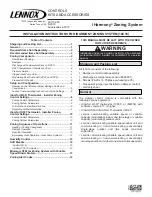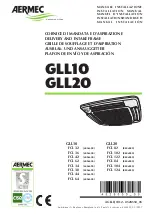
If the first acidity test shows that the acid content is below the safe level, as indicated in the test kit instructions, and the
oil is clean, the clean-out system can be removed. If an in-line suction filter drier was used, it can remain in the system
provided the pressure drop through the filter does not exceed the manufacturers listed pressure drop. For a badly
contaminated system that indicates acid in the oil after 8 to 12 hours of operation, change the suction and liquid line filter-
driers and check the system after 24 hours of operation.
There are instances where contaminants are discovered in a refrigeration system with the compressor still operational.
The same procedure applies, when cleaning these systems, as on a compressor burn-out.
SOURCE OF CONTAMINATION
There are many ways in which a refrigerant system can become contaminated. The most common of these are as
follows:
1. Improper or inadequate dehydration.
2. Wet refrigerant.
3. Wet oil (caution: It is best to purchase oil in small containers and use as needed. Open containers will absorb mois-
ture).
4. Refrigerant leaks (allowing system to operate in a vacuum).
5. Failure to remove oil and moisture after having opened the system for repair.
6. Higher than normal operating temperatures and pressures will cause a breakdown of the oil and refrigerant.
7. Using oil other than specified (Sunoco 3G is recommended).
8. Improper use of soldering or brazing flux.
HIGH PRESSURE SWITCH
A high pressure switch is located in the discharge line and senses the discharge pressure. Should the discharge pressure
exceed 450 psig, the control will open turning off the compressor. The control is designed to protect against excessive
discharge temperatures and pressures which can cause compressor overheating and damage to the motor windings or
valves.
Should the control open, it will remain open until the pressure in the system is lowered to 360 psig. Tripping of the high
pressure control is normally due to:
1. Restricted condenser coil.
2. Overcharge of refrigerant.
3. Defective fan motor or fan capacitor.
4. Incorrect fan blade.
5. Fan motor internal overload tripping due to lack of lubrication or defective bearings.
To test the high pressure control: Install a high pressure gauge to the access valve or the liquid line valve. Disconnect the
condenser fan motor. Turn on the unit and observe the pressure on the gauge when the compressor trip off. The pressure
should be 450 ± 10 psig. Allow the system to remain off, until the gauge pressure drop to approximately 360 ± 15 psig and
reconnect the condenser fan motor. Reset the unit by putting off the thermostat and if the high pressure control has
closed, the compressor will restart.
LOW PRESSURE SWITCH
To provide protection for the compressor in the event of refrigerant loss, a low pressure control is installed in the suction
line.
The control is preset to open when the suction pressure is 25 psig. The contacts of the control will close when the suction
pressure rises to 50 psig. To test the control for the correct pressure setting, install a compound gauge to the gauge port
on the suction service valve. "Front seat" the liquid valve and start the unit. Note the gauge pressure, when the compres-
sor stops.
To determine the cut-in pressure, allow the suction pressure to build slowly and observe the gauge pressure at the time
when contact closes. A good functional low pressure switch must have both cut-out and cut-in pressure within ± 2 psig.
29














































